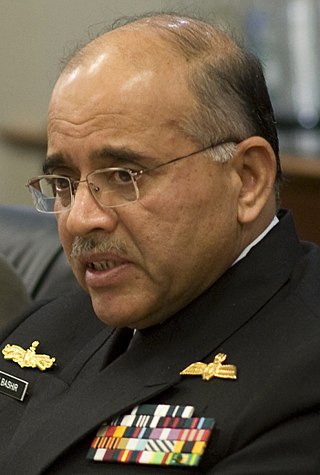
The Pakistan Navy (PN) is the uniform naval warfare branch of the Pakistan Armed Forces. The President of Pakistan is the Supreme Commander of the Navy. The Chief of the Naval Staff, a four-star admiral commands the navy. The Pakistan Navy operates on the coastline of Pakistan in the Arabian Sea and Gulf of Oman. It was established in August 1947, following the independence of Pakistan from the United Kingdom.

Terrorism in Pakistan, according to the Ministry of Interior, poses a significant threat to the people of Pakistan. The wave of terrorism in Pakistan is believed to have started in 2000. Attacks and fatalities in Pakistan were on a "declining trend" between 2015 and 2019, but has gone back up from 2020-2022, with 971 fatalities in 2022.
The Pakistan Rangers are a pair of paramilitary federal law enforcement corps' in Pakistan. The two corps are the Punjab Rangers and the Sindh Rangers. There is also a third corps headquarters in Islamabad but is only for units transferred from the other corps for duties in the federal capital. They are both part of the Civil Armed Forces. The corps' operate administratively under the Pakistan Army but under separate command structures and wear distinctly different uniforms. However, they are usually commanded by officers on secondment from the Pakistan Army. Their primary purpose is to secure and defend the approximately 2,200 km (1,400 mi) long border with neighbouring India. They are also often involved in major internal and external security operations with the regular Pakistani military and provide assistance to municipal and provincial police forces to maintain law and order against crime, terrorism and unrest. In addition, the Punjab Rangers, together with the Indian Border Security Force, participate in an elaborate flag lowering ceremony at the Wagah−Attari border crossing east of Lahore.

The Zulfiquar-class frigate, also known as F-22P or in English: Sword class, is a class of multi-mission guided missile frigates, in service with the Pakistan Navy. The class is based on an updated model of the Chinese design, the Type 053H3. The frigates were designed and built jointly in Hudong–Zhonghua Shipbuilding in China and the KS&EW Ltd. in Pakistan.

The Pakistan Navy Special Service Group is the special operations force tasked with the conducting the small-unit based military operations in all environmental formats of the sea, air, and land by adopting to the tactics of the unconventional warfare.

The insurgency in Khyber Pakhtunkhwa, also known as the War in North-West Pakistan or Pakistan's war on terror, is an ongoing armed conflict involving Pakistan and Islamist militant groups such as the Tehrik-i-Taliban Pakistan (TTP), Jundallah, Lashkar-e-Islam (LeI), TNSM, al-Qaeda, and their Central Asian allies such as the ISIL–Khorasan (ISIL), Islamic Movement of Uzbekistan, East Turkistan Movement, Emirate of Caucasus, and elements of organized crime. Formerly a war, it is now a low-level insurgency as of 2017.

The Pakistani Taliban, officially called the Tehreek-e-Taliban-e-Pakistan, is an umbrella organization of various Islamist armed militant groups operating along the Afghan–Pakistani border. Formed in 2007 by Baitullah Mehsud, its current leader is Noor Wali Mehsud, who has publicly pledged allegiance to the Afghan Taliban. The Pakistani Taliban share a common ideology with the Afghan Taliban and have assisted them in the 2001–2021 war, but the two groups have separate operation and command structures.

Noman BashirNI(M) HI(M) SI(M) TI(M) LoM was a Pakistan Navy admiral who served as the 18th Chief of Naval Staff (CNS) from 7 October 2008 until retiring on 7 October 2011.
The Pakistan Army General Headquarters attack, was a hostage-rescue mission carried by SSG Division on 10 October 2009, when 10 gunmen in military uniform opened fire on the General Headquarters in Rawalpindi, Punjab, Pakistan. The attack killed nine soldiers, nine militants and two civilians and was a major escalation in Pakistan's domestic insurgency. One militant was wounded and captured by security forces. Soon after the attack, the militants infiltrated the security buildings where 22 civilian and military officials were held hostage by the militants. The Pakistan Army immediately launched a hostage rescue operation led by the SSG Division, Army Special Forces and the 13th Regular Regiment.

The Pakistan Naval Air Arm is the naval aviation branch within the Pakistan Navy that is responsible for aerial operations from the seaborne platform.

The PNS Mehran is the naval station and the premier air–to-air/air–to–ground training naval air station located in the joint vicinity of the Faisal Air Force Base in Karachi, Sindh, in Pakistan. Established in 1975 with the cooperation of the Pakistan Air Force, the PNS Mehran serves in the capacity as the headquarter of the Naval Aviation Branch of the Pakistan Navy, and grown to its present inventory of 41 multi role aircraft. The latest addition in the Air Arm is the ATR-72.
The Indo-Pakistani Naval War of 1971 refers to the maritime military engagements between the Indian Navy and the Pakistan Navy during the Indo-Pakistani War of 1971. The series of naval operations began with the Indian Navy's exertion of pressure on Pakistan from the Indian Ocean, while the Indian Army and Indian Air Force moved in to choke Pakistani forces operating in East Pakistan on land. Indian naval operations comprised naval interdiction, air defence, ground support, and logistics missions.
This is a list of terrorist incidents in Pakistan in 2014.
On 8 June 2014, 10 militants armed with automatic weapons, a rocket launcher, suicide vests, and grenades attacked Jinnah International Airport in Karachi, Pakistan. 36 people were killed, including all 10 attackers, and 18 others were wounded. The militant organisation Tehrik-i-Taliban Pakistan (TTP) initially claimed responsibility for the attack. According to state media, the attackers were foreigners of Uzbek origin who belonged to the Islamic Movement of Uzbekistan (IMU), an Al Qaeda-linked militant organisation that works closely with TTP. The TTP later confirmed that the attack was a joint operation they executed with the IMU, who independently admitted to having supplied personnel for the attack.

Operation Zarb-e-Azb was a joint military offensive conducted by the Pakistan Armed Forces against various militant groups, including the Tehrik-i-Taliban Pakistan (TTP), the Islamic Movement of Uzbekistan, the East Turkestan Islamic Movement, Lashkar-e-Jhangvi, al-Qaeda, Jundallah and Lashkar-e-Islam. The operation was launched on 15 June 2014 in North Waziristan along the Pakistan-Afghanistan border as a renewed effort against militancy in the wake of the 8 June attack on Jinnah International Airport in Karachi, for which the TTP and the IMU claimed responsibility. As of 14 July 2014, the operation internally displaced about 929,859 people belonging to 80,302 families from North Waziristan.
The 2014 Quetta airbase attack occurred on 15 August 2014, when approximately 13 Tehrik-i-Taliban militants attempted to storm two airbases of the Pakistan Army and Pakistan Air Force; PAF Base Samungli and Khalid Airbase, both located in Quetta, Balochistan, Pakistan. The attack was largely unsuccessful as Pakistani security forces foiled the attempt following a major armed engagement between the two sides which resulted in the deaths of 12 militants, while 12 people were injured, including one attacker and 11 security personnel.

PNS Zulfiquar (FFG-251) is the lead ship of the F-22P Zulfiquar-class guided missile frigates since 2009. She was designed and constructed by Chinese firm, Hudong-Zhonghua Shipbuilding in Shanghai, for the Pakistan Navy. The vessel's design is primarily influenced from the Type 053H3 frigate.

On 16 December 2014, six gunmen affiliated with the Tehrik-i-Taliban Pakistan (TTP) conducted a terrorist attack on the Army Public School in the northwestern Pakistani city of Peshawar. The terrorists, all of whom were foreign nationals, comprising one Chechen, three Arabs and two Afghans, entered the school and opened fire on school staff and children, killing 149 people including 132 schoolchildren ranging between eight and eighteen years of age, making it the world's fifth deadliest school massacre. Pakistan launched a rescue operation undertaken by the Pakistan Army's Special Services Group (SSG) special forces, who killed all six terrorists and rescued 960 people. In the long term, Pakistan established the National Action Plan to crack down on terrorism.
The 2015 Camp Badaber attack occurred on 18 September 2015, when 14 Tehrik-i-Taliban Pakistan (TTP) militants attempted to storm Camp Badaber, a Pakistan Air Force base located in Badaber, Khyber Pakhtunkhwa, Pakistan. The attack killed 25–29 security personnel, including Captain Asfandyar Bukhari of the Pakistan Army, who was responding to the attack as part of a quick-reaction force. All 14 militants were killed in combat with Pakistani forces, according to claims by security officials. The attack, claimed by the TTP to be in retaliation for the Pakistan Armed Forces' Operation Zarb-e-Azb, was the first of its kind in its intensity, and the well-armed TTP militants engaged Pakistani forces at Camp Badaber in a protracted battle that resulted in heavier losses than those inflicted in previous attacks on military installations. PAF Camp Badaber is located about 48 kilometres (30 mi) east of the Afghanistan–Pakistan border.
Mufti Noor Wali Mehsud, also known as Abu Mansoor Asim, is a Pakistani Islamic scholar, cleric and jurist who is the 4th emir of the Pakistani Taliban. On 22 June 2018, Mehsud was appointed as the emir of TTP after the assassination of former emir Mullah Fazlullah in a US drone strike in Kunar, Afghanistan.










